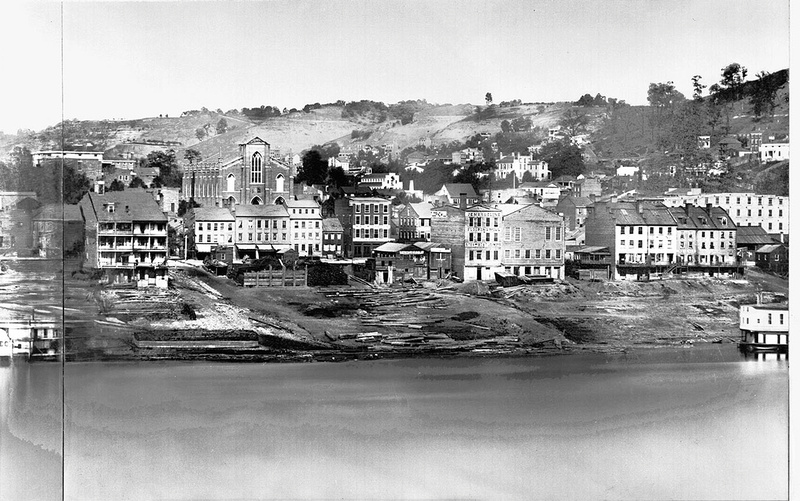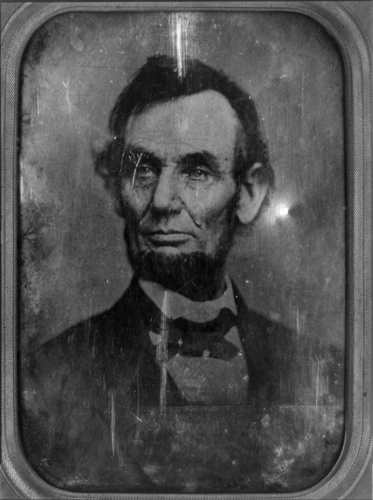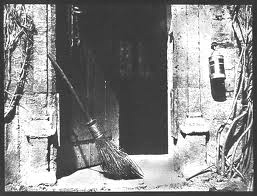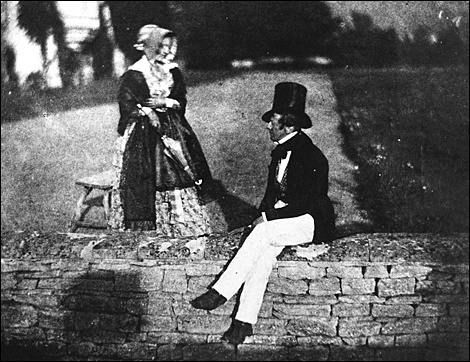The First negative process 1841 Calotype
In the early 1830's while Nie`pce and Daguerre were struggling to capture images on metal plates, others were also at work. One of these was England's Sir John Herschel, who by 1839 had succeeded in capturing images on paper that had been sensitized with carbonate of silver, and who was the first to make them permanent by fixing in hyposulfite of soda.
The noted English scientist William Henry Fox Talbot had also taken a different direction. Talbot first captured images on paper coated with silver chloride. By 1835 he had learned to make these images permanent by washing them in a strong salt solution. To speed up exposure, he worked with very small images some only an inch or so square. These little negative images - curiosities at best - were of little compelling interest, even to Talbot. Between 1835 and the time of Daguerre's dramatic announcements in 1839, Talbot had all but abandoned his line of work. However, when he heard of the news from France, Talbot rushed to claim prior discovery by sending letters to members of the French Academy of Science and a report of his own work with " photographic drawings " to the Royal Society in England. Although his report was widely circulated in the press, his coarse little negative images could not compete for public favor with the larger, brighter, positive dagauerreotype images.
Daguerreotype of Cincinnati 1840's


Embedded in Talbot's report to the Royal Society was the following observation, offered almost casually: " If the picture so obtained is first preserved so as to bear sunshine, it may be afterwards itself employed as an object to be copied, and by means of this second process the lights and shadows are brought back to their original disposition. "
Daguerreotype of One of America's BEST Presidents Abraham Lincoln!


With this statement. Talbot advanced the negative-positive that was to become the basis for nearly all photography after that time. Eclipsed by the popularity of the Daguerreotype and frustrated by the lukewarm interest of the Royal Society, Talbot worked on alone, continuing his experiments with larger cameras and improved lenses. He began using hyposulfite of soda as a fixing agent, as Sir John Herschel had suggested. The following year, he discovered that latent, unseen images resided in the sensitized paper after only a brief exposure, and that they could be made visible by resensitizing the paper. Talbot was thus able to reduce exposure time from many hours to less then a minute. To produce a positive image, Talbot resurrected his negative-positive idea and invented contact printing. He waxed his paper negatives so that they would better transmit light and exposed them to sunlight in contact with photosensitive paper produced positive prints. In 1841 he secured a patent for his process, which he first called the Calotype - beautiful image - but which he was later persuaded to call it the Talbotype.
Calotype


Talbot set up a studio in Reading, outside of London, where he and his employees operated what was probably the world's first photofinishing company! From 1844 to 1846 he produced, probably from this studio, his landmark, six-volume work, " The Pencil of Nature" the first photo illustrated book, each volume containing twenty-four pasted-in calotypes.
Henry Fox Talbot " The Broom " 1844. Calotype from Pencil of Nature, the first book illustrated with photographs!


Talbot's vigorous enforcement of his patent rights discouraged wide spread adoption of his process i England. However, Calotype studios opened elsewhere in Europe without his license. In 1843 David Octavius Hill, a noted landscape painter, and Robert Adamson, a Calotypist, opened a studio in Edinburgh, Scotland. In their four year association they produced more than two thousand calotype portraits, genre and architectural views, and landscapes that remain classics of the Victorian era.
Calotype


The Calotype became more popular in France than elsewhere in Europe. Hippolyte Bayard, an experimenter and noted Daguerreotypist, invented the method of printing in cloud formations and produced memorable calotype landscapes. Gustave Le Gray, whose seascapes were ahead of their time, developed a process for waxing the Calotype paper first to reduce dramatically the paper grain and to give the sensitized paper longer storing properties. In 1851 Louis Desire` Blanquart-Evrard opened a studio in Lille primarily to produce Calotype prints for book illustrations. The 125 pasted-in Calotypes he produced for Maxime Du Camp's " Egypte, Nubie, Palestine et Syrie " in 1851 were a remarkable achievement for the time. He also developed a faster , sharper, glossy-surfaced printing paper using photo salts suspended i the whites of eggs, which enabled him to increase print productions more then 300 percent. This Albumen Paper dominated photographic printing for more then forty years!


Although the Calotype never achieved the popularity of the Daguerreotype, some photographers recognize the aesthetic qualities of the process. Because of it's method of printing through a paper negative, the Calotype was soft and lacked the fine, etched detail of the Daguerreotype. Yet these same qualities produced a soft charcoal like impression that was better suited to the representation of shapes and masses of tone with soft edges - characteristics that appealed to the more interpretive of the early photographers. Further, unlike Daguerreotype , which produced single, unique, unreproducible images, the Calotype process could be used to produce any number of identical prints!


Thus, by the mid 1840's, more than one technology of photography existed. This period of early photography, including both the popular Daguerreotype and the Calotype, was relatively short. It lasted only until the early 1850's. It served, however, to establish photography as an art and craft accessible to the common people like you and I! : )
If you missed the first post on in the series of photography history and would like to start from the beginning Click Here Or if you would like to continue in this series Click Here for the next post on the history of photography!